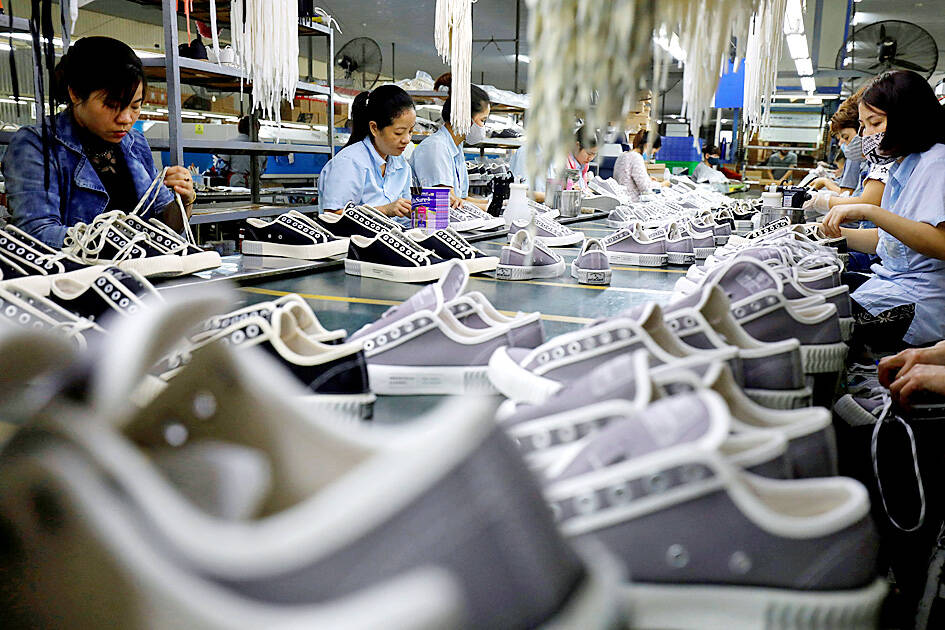One of Vietnam’s largest shoe manufacturers for brands such as Nike Inc and Adidas AG would cut thousands of jobs at the end of next month, blaming a slump in orders, Vietnamese state media reported on Saturday.
LOW DEMAND
The country is among the world’s largest exporters of clothing, footwear and furniture, but has been badly affected by the cost-of-living crisis in Europe and the US, with the buying power of consumers shrinking.

Photo: Reuters
PouYuen Vietnam Co, a unit of Taiwan-based Pou Chen Corp (寶成工業), told local authorities that it would lay off almost 6,000 workers with permanent contracts from the end of next month, VNExpress reported.
“This will be the biggest layoff since PouYuen started its operation in Ho Chi Minh City in 1996,” it said.
The firm is among the commercial capital’s largest employers, with about 50,000 workers.
PRIOR LAYOFFS
However, it made a similar move in February, letting go of almost 3,000 permanent staff, and a further 3,000 temporary employees did not have their contracts renewed.
A third of production facilities in the city experienced reduced workforce demand in the first quarter of this year, a survey by Ho Chi Minh City’s labor department showed.
The downturn mostly affected shoes, clothing, and construction industries, officials said.
PouYuen put 20,000 of its workers on paid leave in rotation last year.
RISING unemployment
More than 630,000 workers lost their jobs or had their hours cut in Vietnam last year, the Vietnamese Ministry of Labor, Invalids and Social Affairs said.

When an apartment comes up for rent in Germany’s big cities, hundreds of prospective tenants often queue down the street to view it, but the acute shortage of affordable housing is getting scant attention ahead of today’s snap general election. “Housing is one of the main problems for people, but nobody talks about it, nobody takes it seriously,” said Andreas Ibel, president of Build Europe, an association representing housing developers. Migration and the sluggish economy top the list of voters’ concerns, but analysts say housing policy fails to break through as returns on investment take time to register, making the

NOT TO WORRY: Some people are concerned funds might continue moving out of the country, but the central bank said financial account outflows are not unusual in Taiwan Taiwan’s outbound investments hit a new high last year due to investments made by contract chipmaker Taiwan Semiconductor Manufacturing Co (TSMC, 台積電) and other major manufacturers to boost global expansion, the central bank said on Thursday. The net increase in outbound investments last year reached a record US$21.05 billion, while the net increase in outbound investments by Taiwanese residents reached a record US$31.98 billion, central bank data showed. Chen Fei-wen (陳斐紋), deputy director of the central bank’s Department of Economic Research, said the increase was largely due to TSMC’s efforts to expand production in the US and Japan. Investments by Vanguard International

WARNING SHOT: The US president has threatened to impose 25 percent tariffs on all imported vehicles, and similar or higher duties on pharmaceuticals and semiconductors US President Donald Trump on Wednesday suggested that a trade deal with China was “possible” — a key target in the US leader’s tariffs policy. The US in 2020 had already agreed to “a great trade deal with China” and a new deal was “possible,” Trump said. Trump said he expected Chinese President Xi Jinping (習近平) to visit the US, without giving a timeline for his trip. Trump also said that he was talking to China about TikTok, as the US seeks to broker a sale of the popular app owned by Chinese firm ByteDance Ltd (字節跳動). Trump last week said that he had

STRUGGLING TO SURVIVE: The group is proposing a consortium of investors, with Tesla as the largest backer, and possibly a minority investment by Hon Hai Precision Nissan Motor Co shares jumped after the Financial Times reported that a high-level Japanese group has drawn up plans to seek investment from Elon Musk’s Tesla Inc to aid the struggling automaker. The group believes the electric vehicle (EV) maker is interested in acquiring Nissan’s plants in the US, the newspaper reported, citing people it did not identify. The proposal envisions a consortium of investors, with Tesla as the largest backer, but also includes the possibility of a minority investment by Hon Hai Precision Industry Co (鴻海精密) to prevent a full takeover by the Apple supplier, the report said. The group is